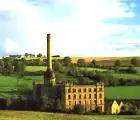
source: Chipping Norton Tourist Information
Until not too long ago ‘Chippy’, apart from being a small market town, had a real industrial base in wool and tweed production. Just outside the town stands Bliss Tweed Mill, designed by George Woodhouse, it looks like a cross between a mansion and a folly, rather than a late 19th century factory having an unusual domed based chimney which is a landmark for Chipping Norton from miles about.
Tweed of high quality was made here for many years. The owner William Bliss was instrumental in bringing the railway here to supply coal for his mill’s steam engines. The Mill finally closed in 1980 and has now been converted to luxury apartments. The town’s railway and its station closed in the 1960s.
source: ChippingNorton.Net
The history of the Bliss Mill, and the family that founded it, began in 1756 when Thomas Bliss came to Chipping Norton selling cloth for his father, a clothier in Chalford, Gloucestershire. He married a local girl, daughter of the landlord of the Swan Inn (West Street), and his father-in-law set him up in small cloth manufacturing in the town. This small beginning evolved through four generations to the world famous Bliss Mill of the 1880s. In 1804, William Bliss (I), 4th son of Thomas, bought an old malthouse in New Street and turned it into a wool store and mill; in 1810 he bought an old flour mill on the Common, which he converted into a water mill for fulling and spinning (this Mill being known as the Lower Mill – on the site of the present Mill). By the time he retired in 1816, William Bliss (I) had established the foundations of the town’s textile business, incorporating all the benefits that the industrial revolution brought. His younger son, William Bliss (II), took over the business in 1839, when his older brother emigrated to America, and he proved to be the most illustrious and remarkable of all the Bliss family, guiding the business to the pinnacle of its fame. In the 1850s a complex of new buildings was added to the Upper Mill, incorporating steam machinery, and the Lower Mill was completely rebuilt – later enlarged and equipped with the latest machinery of the time. The annual turnover increased from £10,000 with eleven employees in 1839, to £260,000 with over 100 employees in 1879.When the Lower Mill on the Common was dramatically destroyed by fire in 1872, not one worker lost his job. Within a year, the Lower Mill was rebuilt as the splendid and distinctive building seen on the Common today. When William Bliss II died in 1884, his son William III struggled unsuccessfully to keep financial control of the business in the family, but in 1893 the Upper Mill complex was sold and in 1895 the firm was declared a limited company. Having lost the business, the Bliss family were unable to bear living in Chipping Norton and they moved away the following year.The Bliss Mill continued to progress with the times, bringing in electricity for lighting in 1904 and for machinery in 1910, but was hard hit by a bitter 8 months strike 1913 –1914. A H Dunstan (who gave his name to the Bliss residence) bought the business in 1917 from the bank, and then sold it in 1920 to Fox Bros. of Wellington, Somerset. The mill finally closed in 1980.